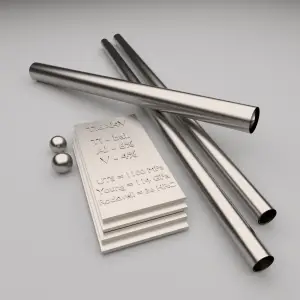 Titanium is a lustrous transition metal with a silver color, low density, and high strength. Titanium is resistant to corrosion in sea water, aqua regia, and chlorine. In power plants, titanium can be used in surface condensers. Pure titanium is stronger than common, low-carbon steels, but 45% lighter. It is also twice as strong as weak aluminium alloys but only 60% heavier. The two most useful properties of the metal are corrosion resistance and strength-to-density ratio, the highest of any metallic element. The corrosion resistance of titanium alloys at normal temperatures is unusually high. Titanium’s corrosion resistance is based on the formation of a stable, protective oxide layer. Although “commercially pure” titanium has acceptable mechanical properties and has been used for orthopedic and dental implants, for most applications titanium is alloyed with small amounts of aluminium and vanadium, typically 6% and 4% respectively, by weight. This mixture has a solid solubility which varies dramatically with temperature, allowing it to undergo precipitation strengthening.
Titanium is a lustrous transition metal with a silver color, low density, and high strength. Titanium is resistant to corrosion in sea water, aqua regia, and chlorine. In power plants, titanium can be used in surface condensers. Pure titanium is stronger than common, low-carbon steels, but 45% lighter. It is also twice as strong as weak aluminium alloys but only 60% heavier. The two most useful properties of the metal are corrosion resistance and strength-to-density ratio, the highest of any metallic element. The corrosion resistance of titanium alloys at normal temperatures is unusually high. Titanium’s corrosion resistance is based on the formation of a stable, protective oxide layer. Although “commercially pure” titanium has acceptable mechanical properties and has been used for orthopedic and dental implants, for most applications titanium is alloyed with small amounts of aluminium and vanadium, typically 6% and 4% respectively, by weight. This mixture has a solid solubility which varies dramatically with temperature, allowing it to undergo precipitation strengthening.
Titanium alloys are metals that contain a mixture of titanium and other chemical elements. Such alloys have very high tensile strength and toughness (even at extreme temperatures). They are light in weight, have extraordinary corrosion resistance and the ability to withstand extreme temperatures.
Composition of Titanium Alloys
Pure titanium and its alloys is commonly defined by their grades defined by ASTM Internation standard. In general, there are almost 40 grades of titanium and its alloys. Following is an overview of the most frequently encountered titanium alloys and pure grades, their properties, benefits, and industry applications.
 Grade 1. Commercially pure titanium grade 1 is the most ductile and softest titanium alloy. It is a good solution for cold forming and corrosive environments. It possesses the greatest formability, excellent corrosion resistance and high impact toughness. Due to its formability, it is commonly available as titanium plate and tubing.
Grade 1. Commercially pure titanium grade 1 is the most ductile and softest titanium alloy. It is a good solution for cold forming and corrosive environments. It possesses the greatest formability, excellent corrosion resistance and high impact toughness. Due to its formability, it is commonly available as titanium plate and tubing.- Grade 2. Commercially pure titanium grade 2 is very similar to grade 1, but it has higher strength than grade 1 and excellent cold forming properties. It provides excellent welding properties and has excellent resistance to oxidation and corrosion. This grade of titanium is the most common grade of the commercially pure titanium industry.
- Grade 5 – Ti-6Al-4V. Grade 5 is the most commonly used alloy and it is an alpha + beta alloy. Grade 5 alloy accounts for 50% of total titanium usage the world over. It has a chemical composition of 6% aluminum, 4% vanadium, 0.25% (maximum) iron, 0.2% (maximum) oxygen, and the remainder titanium. Generally, Ti-6Al-4V is used in applications up to 400 degrees Celsius. It has a density of roughly 4420 kg/m3. It is significantly stronger than commercially pure titanium (grades 1-4) due to its possibility to be heat treated. This grade is an excellent combination of strength, corrosion resistance, weld and fabricability.
- Grade 23 – Ti-6Al-4V-ELI. Ti-6Al-4V-ELI or TAV-ELI is the higher purity version of Ti-6Al-4V. ELI stands for Extra Low Interstitial. The essential difference between Ti6Al4V ELI (grade 23) and Ti6Al4V (grade 5) is the reduction of oxygen content to 0.13% (maximum) in grade 23. Reduced interstitial elements oxygen and iron improve ductility and fracture toughness with some reduction in strength. It’s the top choice for any sort of situation where a combination of high strength, light weight, good corrosion resistance and high toughness are required. This grade of titanium, medical grade of titanium, is used in biomedical applications such as implantable components due to its biocompatibility, good fatigue strength and low modulus.
We hope, this article, Composition of Titanium Alloys, helps you. If so, give us a like in the sidebar. Main purpose of this website is to help the public to learn some interesting and important information about materials and their properties.